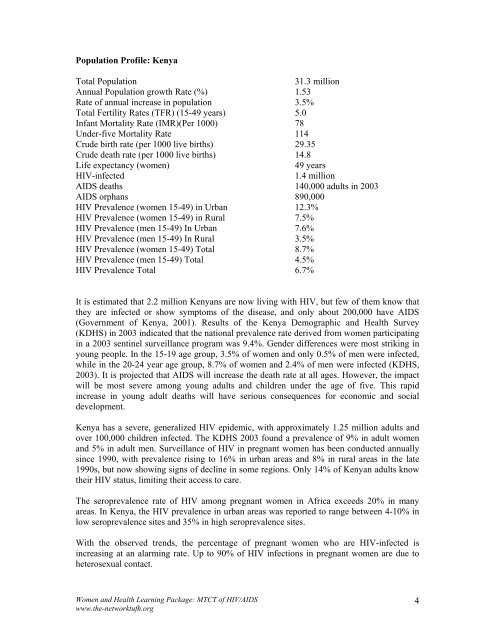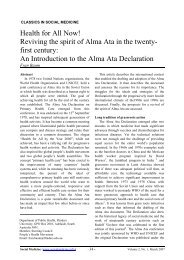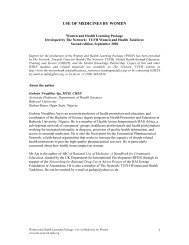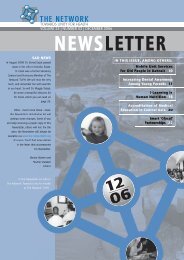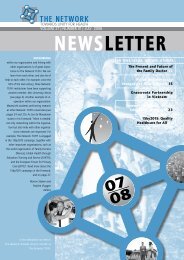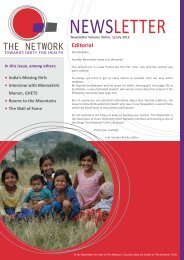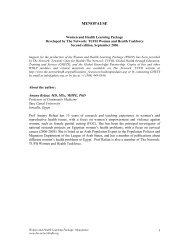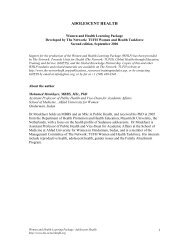WHLP MTCT HIV_AIDS.pdf - The network - Towards Unity For Health
WHLP MTCT HIV_AIDS.pdf - The network - Towards Unity For Health
WHLP MTCT HIV_AIDS.pdf - The network - Towards Unity For Health
Create successful ePaper yourself
Turn your PDF publications into a flip-book with our unique Google optimized e-Paper software.
Population Profile: KenyaTotal Population31.3 millionAnnual Population growth Rate (%) 1.53Rate of annual increase in population 3.5%Total Fertility Rates (TFR) (15-49 years) 5.0Infant Mortality Rate (IMR)(Per 1000) 78Under-five Mortality Rate 114Crude birth rate (per 1000 live births) 29.35Crude death rate (per 1000 live births) 14.8Life expectancy (women)49 years<strong>HIV</strong>-infected1.4 million<strong>AIDS</strong> deaths 140,000 adults in 2003<strong>AIDS</strong> orphans 890,000<strong>HIV</strong> Prevalence (women 15-49) in Urban 12.3%<strong>HIV</strong> Prevalence (women 15-49) in Rural 7.5%<strong>HIV</strong> Prevalence (men 15-49) In Urban 7.6%<strong>HIV</strong> Prevalence (men 15-49) In Rural 3.5%<strong>HIV</strong> Prevalence (women 15-49) Total 8.7%<strong>HIV</strong> Prevalence (men 15-49) Total 4.5%<strong>HIV</strong> Prevalence Total 6.7%It is estimated that 2.2 million Kenyans are now living with <strong>HIV</strong>, but few of them know thatthey are infected or show symptoms of the disease, and only about 200,000 have <strong>AIDS</strong>(Government of Kenya, 2001). Results of the Kenya Demographic and <strong>Health</strong> Survey(KDHS) in 2003 indicated that the national prevalence rate derived from women participatingin a 2003 sentinel surveillance program was 9.4%. Gender differences were most striking inyoung people. In the 15-19 age group, 3.5% of women and only 0.5% of men were infected,while in the 20-24 year age group, 8.7% of women and 2.4% of men were infected (KDHS,2003). It is projected that <strong>AIDS</strong> will increase the death rate at all ages. However, the impactwill be most severe among young adults and children under the age of five. This rapidincrease in young adult deaths will have serious consequences for economic and socialdevelopment.Kenya has a severe, generalized <strong>HIV</strong> epidemic, with approximately 1.25 million adults andover 100,000 children infected. <strong>The</strong> KDHS 2003 found a prevalence of 9% in adult womenand 5% in adult men. Surveillance of <strong>HIV</strong> in pregnant women has been conducted annuallysince 1990, with prevalence rising to 16% in urban areas and 8% in rural areas in the late1990s, but now showing signs of decline in some regions. Only 14% of Kenyan adults knowtheir <strong>HIV</strong> status, limiting their access to care.<strong>The</strong> seroprevalence rate of <strong>HIV</strong> among pregnant women in Africa exceeds 20% in manyareas. In Kenya, the <strong>HIV</strong> prevalence in urban areas was reported to range between 4-10% inlow seroprevalence sites and 35% in high seroprevalence sites.With the observed trends, the percentage of pregnant women who are <strong>HIV</strong>-infected isincreasing at an alarming rate. Up to 90% of <strong>HIV</strong> infections in pregnant women are due toheterosexual contact.Women and <strong>Health</strong> Learning Package: <strong>MTCT</strong> of <strong>HIV</strong>/<strong>AIDS</strong>www.the-<strong>network</strong>tufh.org4


